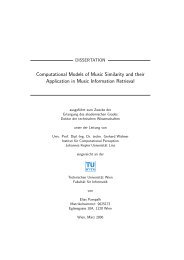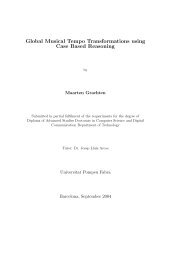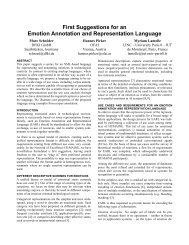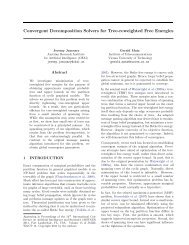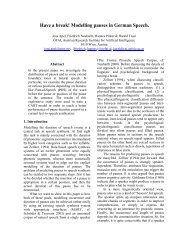A HYBRID MODEL OF REASONING BY ANALOGY
A HYBRID MODEL OF REASONING BY ANALOGY
A HYBRID MODEL OF REASONING BY ANALOGY
Create successful ePaper yourself
Turn your PDF publications into a flip-book with our unique Google optimized e-Paper software.
The c-coref (short for `conceptual coreference') slot points to other conceptual descriptions of the<br />
same entity, i.e. each two descriptions linked to each other by a c-coref link refer to one and the<br />
same entity in the world. This allows for multiple descriptions of one and the same object, concept,<br />
situation, etc. The c-coref facet of a slot is used to represent a c-coref link between a part of the<br />
description and another description or part of it. This facet replaces the value and range facets,<br />
provides a way of specialization of an ancestor slot and also makes it possible for two or more<br />
frames to share some information and in this way to build a frame-array (Minsky, 1975, 1986). A<br />
detailed description of all these properties can be found in (Kokinov, 1989).<br />
The a-links (short for "associative links") represent arbitrary associations corresponding to any<br />
type of co-occurrence or other vague semantic relations. They are not recognized by the symbolic<br />
processors and are used only by the connectionist aspect of the architecture. For example, such<br />
links are built between characteristic features often found together, between two events that have<br />
occurred within a short period of time, from class descriptions to their elements or subclasses, etc.<br />
These links enable the computation of associative relevance of the particular pieces of knowledge<br />
linked.<br />
Besides these common slots, each frame may have an unlimited number of special slots. They can<br />
be of three types: aspects, relations, and actions. The aspect slots of a frame correspond to<br />
structural or functional parts of a concept (e.g. a handle of a cup), abstract aspects of a concept<br />
(e.g. a scientist's research area), or roles in a relation or an action (e.g. the agent, the object, and<br />
the recipient in an action of giving). The relation slots correspond to relationships between different<br />
aspects of the same concept or between different concepts or their aspects (e.g. in a frame<br />
describing a situation, aspects can correspond to objects, whereas relations - to their attributes or<br />
relations between them). Action slots correspond to pieces of behavioral knowledge attached to the<br />
concept or situation (e.g. how to act in such a situation). This may be viewed as the hard-wired<br />
knowledge of the corresponding symbolic processor.<br />
4.7. Marker Passing Mechanism<br />
The role of the marker-passing mechanism :- In contrast to the associative mechanism which<br />
performs an undirected and unspecified search and produces only numeric reports, the markerpassing<br />
mechanism performs a specialized search traversing only the links of a specified type (e.g.<br />
either is-a links or instance-of links or c-coref links, or a certain combination of these types) and<br />
keeps track of the path followed. It is actually a mechanism for directed parallel retrieval. This<br />
mechanism is used for establishing the causal relevance of a particular element as well as for<br />
establishing the semantic similarity between various elements during the mapping process.<br />
The mechanism has two different versions. In the first case, it starts from two nodes in the<br />
network and looks for paths beginning at these nodes, consisting of the links of the given type(s)<br />
and ending at one and the same node. In the most typical case the links involved are traversed<br />
possibly starting with one instance-of link (which may be omitted) and then continuing with an<br />
unspecified number of is-a or c-coref links in an unspecified order. Such a search will answer the<br />
question whether two given descriptions corresponding to the two starting nodes have a common<br />
super- or metaclass (i.e. they are subclasses or elements of one and the same class); this is used<br />
during the mapping process as well as during the evaluation process.<br />
There is a second, slightly different version of the marker passing mechanism where a<br />
correspondence of the same type is sought between the elements of two given sets of nodes. This<br />
mechanism is used during the mapping process as well.<br />
The marker passing mechanism itself :- In the first case, it marks the two starting nodes with two<br />
different markers, e.g. A and B, which are then passed through the specified links, marking all




